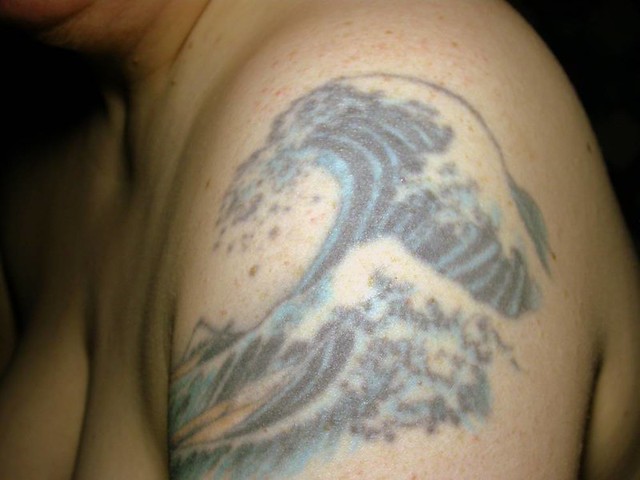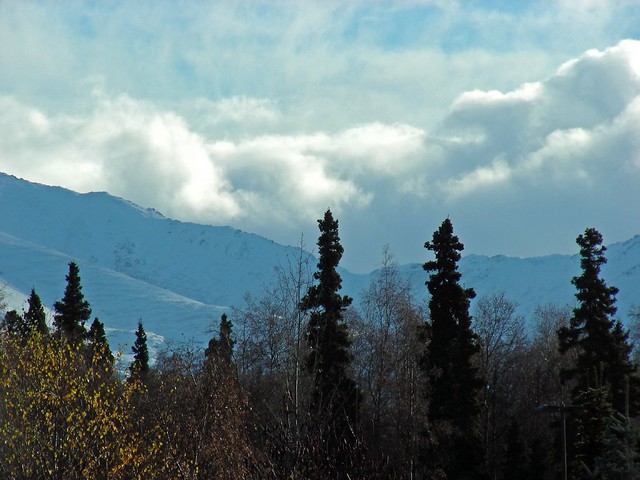A couple of days ago Andrew Sullivan highlighted a post by former Anglican priest Mark Vernon, in his blog “Philosophy and Life.” Vernon’s post which he called “The great waves of Japan”, is worth quoting in full:
I was hearing about the famous painting, The Great Wave of Kanagawa, by Hokusai. It captures something of the horror of what’s fallen northern Japan, with its image of the fishermen dwarfed by the majestic, indifferent tower of water.
It’s a religious image, representing the very different approach that Shintoism has towards nature, compared with Christianity. In Christianity, human beings are at the centre of nature: creation is for humanity, along with other creatures, and it’s humanity’s task to care for it. Hence, in part, the offence we feel when nature turns against us.
In Shintoism, nature is recognised as infinitely more powerful than humankind — as in the wave — and that humankind is in nature with the permission of the gods but with no particular concern from the gods. Shinto rituals show respect for the gods of nature, befriending the enormity of the forces, if you like. But, apparently, there won’t be much of the moral affront at what’s happened — the problem of evil — from the Japanese perspective.
Vernon explained further in response to a commenter’s question,
The problem of evil arises from the Christian doctrine that an all-powerful and good God made the world for us, in some sense, though that world is full of horrors. How come? In the Shinto cosmology, though, the gods are not anthropocentric with their attention, so Shintoism teaches, as I understand it, that one should expect evil from nature quite as much as good.
Good and evil — that’s the question that theologians call theodicy (not to be confused with Homer’s masterpiece The Odyssey, though they’re pronounced much the same). Theodicy comes from the Greek, theos “god” + dike “justice” (Dikē was the Greek goddess of moral justice), & has to do with trying to reconcile a benevolent all-powerful God (especially as understood in Christianity & other monotheistic religions like Judaism & Islam) with the existence of evil. Or with, simply, the fact that bad things happen to good people — as happened, & is happening, to the people of Japan in the aftermath of last week’s devastating earthquake & tsunami.
I’ve written on this blog about theodicy before — most extensively just a little over a year ago, after Christianist lackwit Pat Robertson blamed the January 2010 Haiti earthquake on Haitians.
And sure enough, another lackwit, this time Glenn Beck of Fox News, has made a similar suggestion about the Japan quake. So has South Korean pastor David Yonggi Cho of Yoido Full Gospel Church, the largest Christian church in the world. Meanwhile, a longtime Internet troll who posed as an extreme Christianist pulled her YouTube account after public outrage over a video she posted last Monday praising God for killing the “atheist” victims of the quake. Her authenticity had apparently long been debated; but, strikingly, a lot of people believed she was for real. After all, many Christianists are routinely just as offensive, even as they earnestly call upon others to worship a god whose “acts of god” they attribute to their god’s own enforcement of ideological purity.
(It sure as hell ain’t to enforce moral purity that a god would slaughter innocents by the thousands.)
(Reminder: Christian and Christianist — not the same thing. A Christian is a follower of the Christian faith, whatever politics she or he might follow — conservative, moderate, liberal, independent. A Christianist is one whose supposed Christianity has become, in the words of Andrew Sullivan, “ideology, politics, an ism…. It is the belief that religion dictates politics and that politics should dictate the laws for everyone, Christian and non-Christian alike.”)
But back to what Vernon said about Shintoism:
In the Shinto cosmology, though, the gods are not anthropocentric with their attention, so Shintoism teaches, as I understand it, that one should expect evil from nature quite as much as good.
(I don’t think that a natural event like an earthquake or tsunami has a moral dimension such as evil per se; but beyond that quibble) … there’s a book of the Bible that teaches much the same: the Book of Job. As Stephen Mitchell writes in the introduction to his 1992 translation of the Book of Job regarding Job and his friends, who are “comforting” Job after he’s lost nearly everything, including all his children:
The friends and Job all agree that God is wise and can see into the hearts of men. He is not the kind of character who would allow a good man to be tortured because of a bet; nor is he a well-intentioned bungler. Given this premise, they construct opposite syllogisms. The friends: Suffering comes from God. God is just. Therefore Job is guilty. Job: Suffering comes from God. I am innocent. Therefore God is unjust. A third possibility is not even thinkable: Suffering comes from God. God is just. Job is innocent. (No therefore.)
And later,
[Job] wants to die; he wants to prove that he is innocent; he wants to shake his fist at God for leaving the world in such a wretched shambles. God is his enemy; God has made a terrible mistake; God has forgotten him; or doesn’t care; God will surely defend him, against God. His question, the harrowing question of someone who has only heard of God, is “Why me?” There is no answer, because it is the wrong question.
The harrowing question of someone who has only heard of God. But then the Voice from the Whirlwind comes, and Job not only hears but actually sees:
The storm rumbled and thundered. The wind tore at my clothing
and took my breath. I could not stand or speak,
and she had not the breath to make a curse.
Here was the justice of the Unnameable!
We would be smitten by that self-same howling wind
that had poured from the desert like a band of outlaws
to destroy my sons and murder my daughters.And then was stillness, as death, a steep silence.
And look! we raised our eyes to the maelstrom’s clouded throat,
dizzied. Spinning vapors formed and broke away and blew;
lightning flashed in the turbulent dark belly of the wind.
I was dust to be blown by that wind but was not blown.
I stood under the very eye of the Unnameable. And within me grew a stillness.(from my poem “Job 42.13”)
It’s hard to put into words what Job’s experience of the Unnameable was, that we so often name “God” — and which I name as god with a lower case g, the very substance & being & energy of which the universe & everything in it has its being. The poet of Job did a damn good job, nonetheless, of pointing to what that wordless and awesome and terrifying and profound experience was.
But none of it has a damn thing to do with human understandings of justice and injustice, of good and evil. It just is what it is. Sometimes bad things happen to good people. In hopes of being good people ourselves, let’s help those who need our help.
* * *
“Behind the Great Wave at Kanagawa” (神奈川沖波裏) by Hokusai (1760–1849) is actually not a painting, but rather a color woodcut. It’s one of the series “36 Views of Mount Fuji.” I come by the reproduction of it at the head of this post by way of Wikimedia Commons. The Wikimedia contributor comments, “Although it is often used in tsunami literature, there is no reason to suspect that Hokusai intended it to be interpreted in that way. The waves in this work are sometimes mistakenly referred to as tsunami (津波), but they are more accurately called okinami (沖波), great off-shore waves.” M.J. a commenter on Vernon’s blog post, shared the explanation given him/her by a docent at the Smithsonian Sackler Gallery during a Hokusai exhibit there:
All the diagonal lines and dots represent movement, things not always remaining the same. Some of Hokusai’s paintings, such as this one, depict scary moments like this big storm. You can see the ends of the waves looking almost like claws, which are scary but also symbolize our wishing to hang on to things the way they are, not wanting things to change. Our wish for things to remain the same makes the situation look worse than it really is.
When you look closely at this picture, the waves don’t don’t look so scary and are actually quite beautiful…. In this painting, you can see people in boats huddled together and crouching down. This is not because they’re scared but because they know how they should position themselves to take on this challenge. Actually, they seem to be in reverence of the big waves. In the midst and at the end of this picture is Mt. Fuji, representing calm at the end of the storm.
A good meaning; and also, I think, one which ties well with the peace, even joy, of Job by the end of the book that bears his name. The end of my poem “Job 42.13” —
There are tears now in her eyes as she watches them play —
yes, seven sons, three daughters — as before.
I rejoice in them, but also grieve for our windlost children —
the only love I gave them was to make burnt offerings
against sins I feared lay hidden in their unknown hearts.But listen! they laugh! she laughs! And I laugh, too.
May it be so also for the survivors of Japan.
* * *
The Book of Job is obviously important to me — my favorite of all the books of the Bible. But Hokusai’s Great Wave has also been important to me, ever since I got it engraved in my skin in December 1983.
Due to the process used by the tattoo artist — Larry Allen of Anchorage Tattoo Studio —my tatt is a mirror image of Hokusai’s original.
At the time it was done, I was still deeply enmeshed in my pre-aha period of self-hatred and almost continual despair. But I had come across to a reference somewhere to the Chinese ideogram that we translate as crisis. According to my source (which may or may not be correct), the Chinese character literally meant opportunity rides a dangerous wind.
Or something to that effect. That’s, at least, how I wrote it in a poem the following year, after the aha. And there is Hokusai as well, his Great Wave etched on my arm, linked to the meaning (putative or not) of that Chinese character —
On my arm, tattooed, is the large wave, the boats,
the mountain — my life, crisis on crisis:
opportunity rides on the dangerous wind.
It’s wonderful then to read what the commenter on Vernon’s post said about Mt. Fuji in Hokusai’s woodcut:
In the midst and at the end of this picture is Mt. Fuji, representing calm at the end of the storm.
Or the Chugach Mountains, for me —
Day followed day, the old stream of time,
just the same as before.
But each day I saw the mountains change —
one day growing gold in the afternoon sun —
one day dusted white by the season’s first snow —
one day touched by clouds as soft as white roses —
I could see them and breathe them and touch them and feel them.
Each day I saw the mountains change —
so did change find me.




One Response to Good, evil, & great waves of god